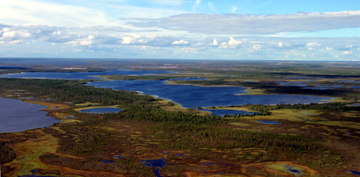 Millions
of lakes dot the marshy Arctic tundra regions. Now, in the latest addition to
the growing body of evidence that global warming is significantly affecting
the Arctic, two recent studies suggest that thawing permafrost is the cause
of two seemingly contradictory observations — both rapidly growing and
rapidly shrinking lakes.
Millions
of lakes dot the marshy Arctic tundra regions. Now, in the latest addition to
the growing body of evidence that global warming is significantly affecting
the Arctic, two recent studies suggest that thawing permafrost is the cause
of two seemingly contradictory observations — both rapidly growing and
rapidly shrinking lakes. Thawing permafrost is altering the lakes that dominate Arctic landscapes, such as this one in western Siberia. Courtesy of Laurence C. Smith.
The first study is a historical analysis of changes to 10,000 Siberian lakes over the past 30 years, a period of warming air and soil temperatures. Using satellite images, Laurence Smith, a geographer at the University of California, Los Angeles, and colleagues found that, since the early 1970s, 125 Siberian lakes vanished completely, and those that remain averaged a 6 percent loss in surface area, a total of 930 square kilometers.
They report in the June 3 Science that the spatial pattern of lake disappearance suggests that the lakes drained away when the permafrost below them thawed, allowing the lake water to seep down into the groundwater. However, the team also found that lakes in northwestern Siberia actually grew by 12 percent, and 50 new lakes formed. Both of the rapid changes are due to warming, they say, and if the warming trend continues, the northern lakes will eventually shrink as well.
“These two processes are similar, in that we’re witnessing permafrost degradation in both regions,” says co-author Larry Hinzman, a hydrologist at the University of Alaska in Fairbanks, who in previous studies documented shrinking lakes in southern Alaska. “In the warmer, southern areas, we get groundwater infiltration, but in the northern areas, where the permafrost is thicker and colder, it’s going to take much, much longer for that to occur. So instead of seeing lakes shrinking there, we’re seeing lakes growing.”
That finding is consistent with the second study, which focused on a set of unusually oriented, rapidly growing lakes in northern Alaska, an area of continuous permafrost. Jon Pelletier, a geomorphologist at the University of Arizona in Tucson, reports in the June 30 Journal of Geophysical Research — Earth Surface that the odd alignment of the lakes is caused not by wind direction but by permafrost melting faster at the downhill end of the lake, which has shallower banks.
Since the 1950s, scientists have attributed the odd alignment of the egg-shaped lakes to winds blowing perpendicularly to the long axes of the lakes, which then set up currents that caused waves to break at the northwest and southeast ends, thus preferentially eroding them. “The prevailing wind direction idea has been around so long that we don’t even think about it,” Smith says, “but Jon’s [Pelletier] work is challenging that. It’s a very interesting paper.”
Wind-driven erosion occurs in the Great Lakes, but at rates of about a meter a year. The Alaskan oriented thaw lakes grow at rates of 5 meters or more per year. Pelletier says this rate difference suggests a different process is at work.
According to the model, the direction and speed of growth depend on where and how quickly the permafrost thaws, which is determined by two factors: how the water table intersects the slope of the landscape and how fast the summer temperature increases. If the permafrost thaws abruptly, the shorter, downhill bank is more likely to thaw first. The soggy soil slumps into the water, and the perimeter of the lake is enlarged. “It’s not just the [global] warming trend, but also how quickly the warming takes place in the summertime,” Pelletier says.
Hinzman says that the lakes are just one part of the Arctic water cycle, which has seen an increasing number of perturbations in recent years. “The whole hydrologic cycle is changing and this is just one component of that.”
Understanding how the hydrologic cycle is changing is important, Hinzman says, because the amount of freshwater runoff into the Arctic Ocean impacts global ocean circulation and the amount of sea ice, thus affecting climate worldwide. “If global warming continues to the point where permafrost goes away, there will be fewer lakes,” Smith says. And a drier, less marshy Arctic could alter weather patterns and ecosystems, researchers say, affecting everything from the subsistence lifestyle of native people to the hazard of fire on the tundra.

